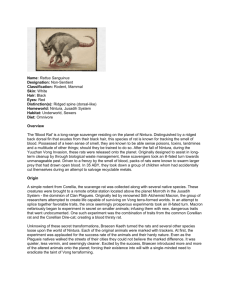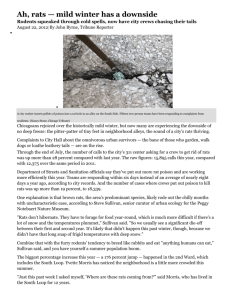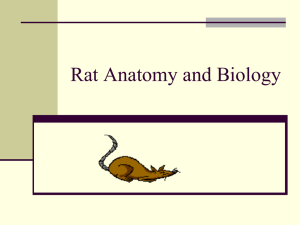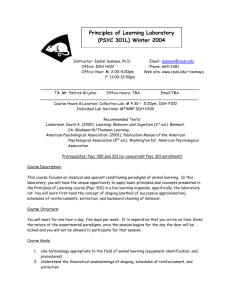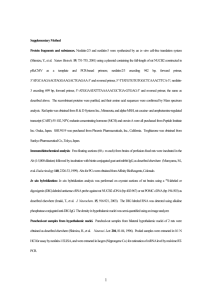AnnaJournalClub
advertisement
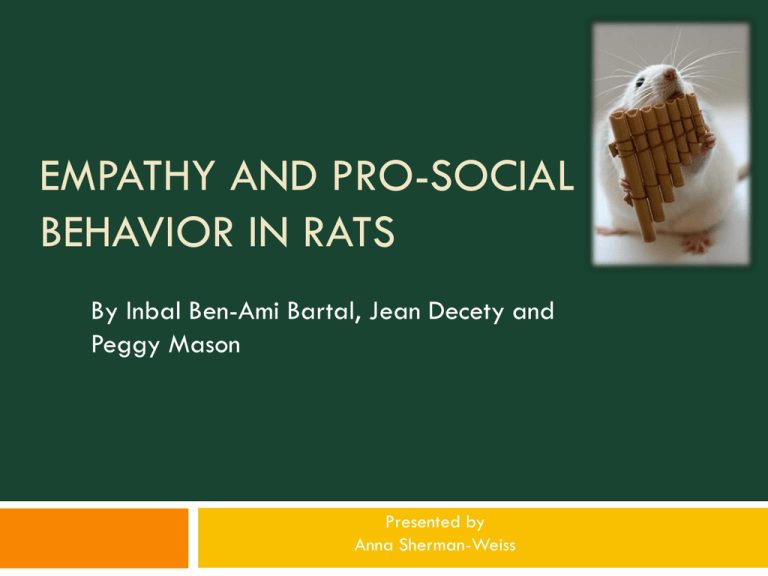
EMPATHY AND PRO-SOCIAL BEHAVIOR IN RATS By Inbal Ben-Ami Bartal, Jean Decety and Peggy Mason Presented by Anna Sherman-Weiss What is being tested? Human Pro-Social Behavior is driven by empathic concern for another. Is the same true for non-primate mammals? What is Pro-Social Behavior? The act of helping another being with no other motive then to help To “benefit other people or society as a whole” What is empathy? Beyond basic level of emotional contagion “Emotional response elicited by and congruent to with the perceived welfare of an individual in distress” Pro-social behavior is emphatically driven when the emotional response can be down-graded so that it doesn’t prevent the empathic being from helping the one in need How is it being tested? Test 1: The effect of a trapped cagemate on pro-social motivation Controls: Empty restrainer, restrainer with toy rat, one rat with an empty restrainer separated from another free rat by a perforated divider. *Rats were housed together 2 weeks before testing Test 2: The effect of an individual’s boldness Test 3: The effect of anticipation of social interaction Test 4: The relative value of liberating a cagemate (rat vs chocolate chips) https://vpn.mountsinai.org/VideoLab/1310979895001/,DanaInfo=video.sciencemag.org+1 What did they find? Test 1: Average time to open the cage: 6.9±2.9 days Rats with live cagemates moved faster and spent more time by the restrainer – more motivated to assist a rat in need Rats learned- number of rats opening the restrainers increased, the speed to open the door decreased and the reaction to opening decreased with time Rat activity increased after cagemate was freed major event Door-Opening Method 1. Tipping door from side • 2. Tipping door from top 3. Pushing it with their heads On days 6-12- only with head (anticipated a specific outcome achieved by a deliberate tactic What did they find? Test 1 cont. Ultrasonic Vocalizations More alarm calls were recorded when a living cagemate was present More often in the beginning (20-27%) days 1-3 Day 1: 90% of calls emitted by trapped, stressed rat, others are unidentifiable Male vs Female A higher rate of female mice became door openers (6/6 vs 17/24) Female rats opened the restrainers faster than males (days 7-12) Female rats were more active than males in only the trapped condition Females more empathetic? What did they find? Test 2: Individual Boldness Tested quickness to explore a half-opened cage prior to testing Correlation between the two – boldness is a possible factor in pro-social behavior expression What did they find? Test 3: Anticipation of Social Interaction as a Motive Set-up: trapped animal could only exit into a different arena Step 1: Exposed to trapped condition Step 2: Put in either an arena with an empty restrainer or a contained (separate) cagemate Step 3: Switched conditions Exposed to separated cagemate: continued to open door at same rate as trapped condition Exposed to separated empty restrainer: stopped opening the door Opened cages with rats even without social contact suggesting it is not a motive What did they find? Test 4: The Relative Value of Liberating a Cagemate (Rat vs Chocolate) Evaluated value of food reward: non-food-deprived rate ate an average of >7 chips and no rat food Chocolate/Cagemate Condition: No difference in the door-opening latency for both restrainers (days 6-12) Chocolate/Empty Condition: Opened chocolate faster Suggested that chips and fellow rats are considered relatively equal. Rats share! In 52% of all trials and 61% on days 6-12. When no cagemate, rat ate an average of 4.8± 0.7 chips out of 5 With a cagemate, free rats ate 3.5±1.5 chips What does it mean? Not enough rat alarm noises to support the idea that the rats just wanted to stop the alarm calls Curiosity wouldn’t have lasted a month Latency to open the door decreased and it is not an easy task making the reason of coincidence with high activity seem unlikely They conclude: rats free cagemates to end their personal and/or peer’s distress. Emotional motive drives the prosocial behavior. So what? Why is it important? Rats exhibit pro-social behavior when they recognize a conspecific experiencing nonpainful psychological restraint stress and deliberately act to end that distress (no training or rewards) Pro-social behavior helps to promote the well-being of a population and gene pool A supportive community, taking care of each other when an individual or group is in need, ensures survival and the passing on of desirable genes Concluding Questions What difference does it make if non-primates have empathy as well? Does the difference between male and female rats’ opening rates make you consider the empathy and gender any differently? Is it more nature than we realize? What would the outcomes be if the rats had not become been housed together two weeks prior to testing? At a certain does this form of empathy go against natural selection? (Freeing a stupid rat to make stupid rat babies, not taking all the chocolate for oneself) Or is this altruistic, pro-social action “a pact” guaranteeing a helpful relationship in the future? Bibliography http://changingminds.org/explanations/theories/prosocial_behavior.htm http://en.wikipedia.org/wiki/Prosocial_behavior
